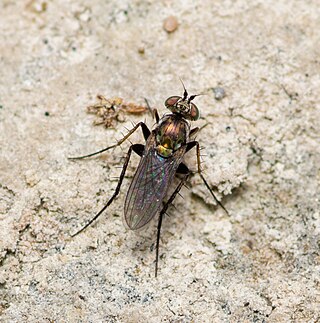Anasyntormon is a genus of flies in the family Dolichopodidae. It was originally placed in the subfamily Rhaphiinae near Syntormon. It was transferred to Dolichopodinae by Hans Ulrich (1980), who found it to be congeneric or closely related to Hercostomus.

Arachnomyia is a genus of flies in the family Dolichopodidae. It is known from Australia.

Chrysosoma is a genus of flies in the family Dolichopodidae. It is a large genus, with more than 200 species distributed in the Old World and Oceania.
Ischiochaetus is a genus of flies in the family Dolichopodidae, found in New Zealand. The genus was originally named by Octave Parent in 1933. However, as the genus was not designated a type species, this name was unavailable until 1989, when Daniel J. Bickel and C. E. Dyte designated Ischiochaetus ornatipes as the type species.

Liancalus is a genus of flies in the family Dolichopodidae. It contains at least 21 species distributed worldwide except in Australasia and Oceania. The genus includes some of the largest species in the family, with body length approaching 12 mm in some species.

Medetera is a large genus of flies in the family Dolichopodidae. It includes about 350 species worldwide. The adults are commonly found resting on vertical surfaces such as tree trunks, on which they have a characteristic vertical upright stance. Because of this stance, they are sometimes known as "woodpecker flies". Medetera adults are predators of soft-bodied arthropods, while the larvae are predators of bark beetle larvae.
Nurteria is a genus of flies in the family Dolichopodidae, found in the Afrotropical realm. Three species are currently known in the genus, but there are also numerous undescribed species of the genus from southern Africa. It was originally described in the subfamily Diaphorinae, though it possesses some features of the Sympycninae.

Paraclius is a genus of flies in the family Dolichopodidae.
Peloropeodes is a genus of flies in the family Dolichopodidae.
Scelloides is a genus of flies in the family Dolichopodidae, found in New Zealand. The genus was originally named by Octave Parent in 1933. However, as the genus was not designated a type species, this name was unavailable until 1989, when Daniel J. Bickel and C. E. Dyte designated Scelloides ornatipes as the type species.
Terpsimyia is a genus of fly in the family Dolichopodidae. It is known from the Indomalayan realm, and contains only one species, Terpsimyia semicincta, known from Taiwan and Thailand.

Tetrachaetus is a genus of flies in the family Dolichopodidae, found in New Zealand. The genus was originally named by Octave Parent in 1933. However, as the genus was not designated a type species, this name was unavailable until 1989, when Daniel J. Bickel and C. E. Dyte designated Tetrachaetus bipunctatus as the type species.

Thinophilus is a genus of flies in the family Dolichopodidae. It includes about 146 described species distributed worldwide. Most species of the genus are found in coastal habitats, while a few species are found in freshwater habitats.

Hydrophorinae is a subfamily of flies in the family Dolichopodidae. Several studies have found evidence that the subfamily in its current sense is polyphyletic.

Sciapodinae is a subfamily of flies in the family Dolichopodidae.

Diaphorinae is a subfamily of flies in the family Dolichopodidae.

Peloropeodinae is a subfamily of flies in the family Dolichopodidae. In some classifications, the genera of the subfamily are included in Sympycninae. According to Germann et al. (2011), the subfamily is polyphyletic.

Sympycninae is a subfamily of flies in the family Dolichopodidae. In some classifications, this subfamily includes the genera of the subfamilies Peloropeodinae and Xanthochlorinae.












